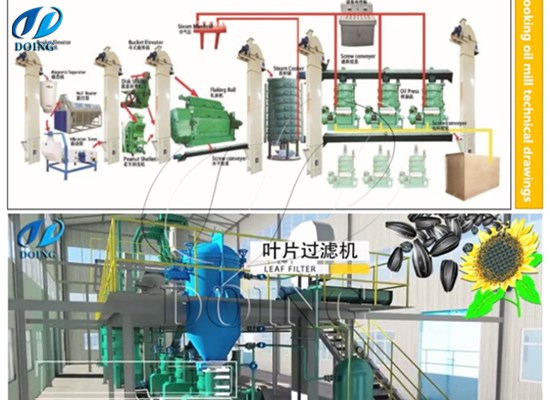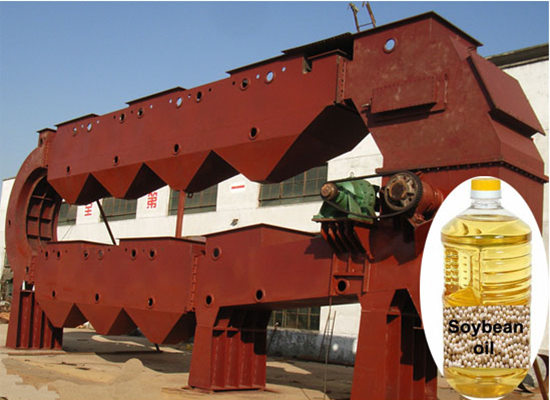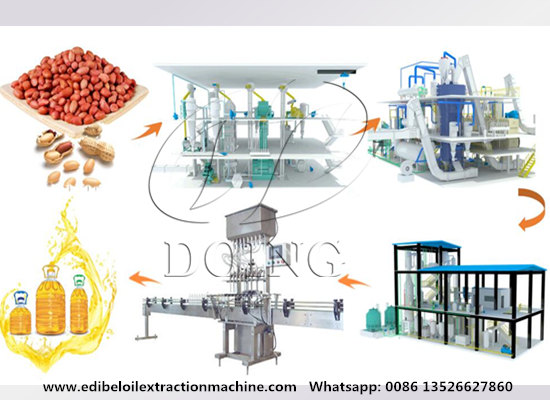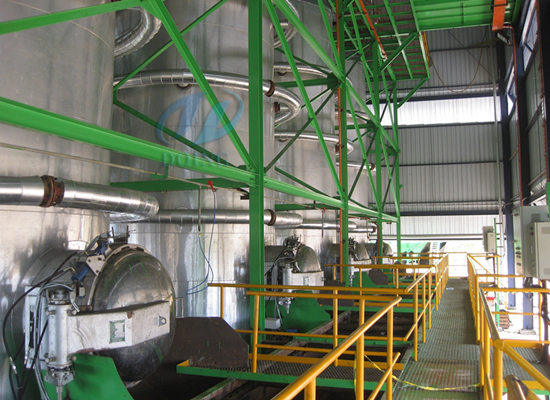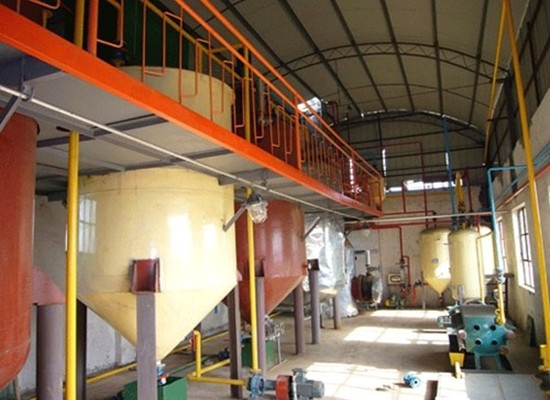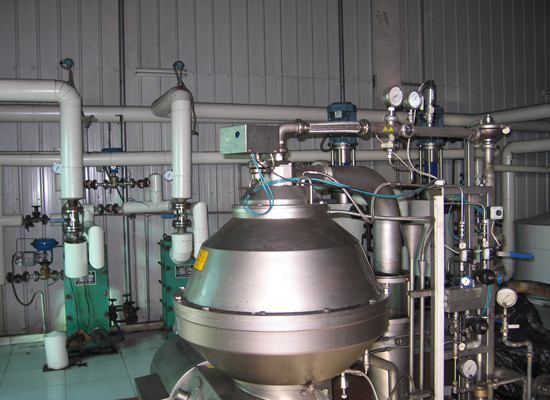Edible oil refining manufacturing in africa
June 7, 2018 16:36/ Industry News/ leave a message
Starting edible oil refining manufacturing in Africa, to replace the imported, mass-produced brands, is now possible with the collaboration of experts in the field of oils : Henan Doing Mechanical Equipment Co.,LTD
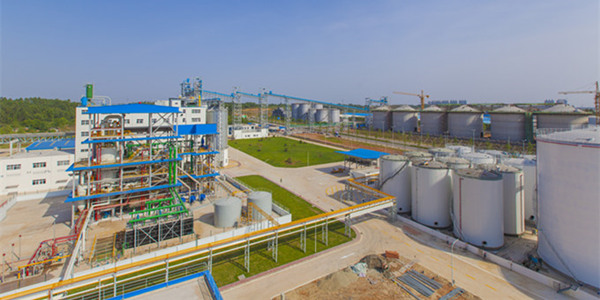
Large scale edible oil refinery plant
Edible Oil Refining Production Line
We recommend the most suitable and cost effective edible oil refining production lines to start a local edible oil refining manufacture. Before starting an edible oil refining factory, it is very important to decide scale.
Crude oil obtained from expellers or solvent extraction, contains impurities. To make the oil edible, the impurities must be taken out; such a process is called “oil refining(oil refinery plant)”. Oil Refining (Oil Refinery Plant) means conversion from crude oil to direct human consumption, crude oil refinery, edible oil refinery, oil refinery projects and industrial purpose.
In general, oil refinery plant divides to 3 types: batch oil refinery plant, semi-continuous oil refinery plant, continuous oil refinery plant. These 3 oil refinery plants are used for different capacity. But the processes in each oil refinery plant are almost the same.
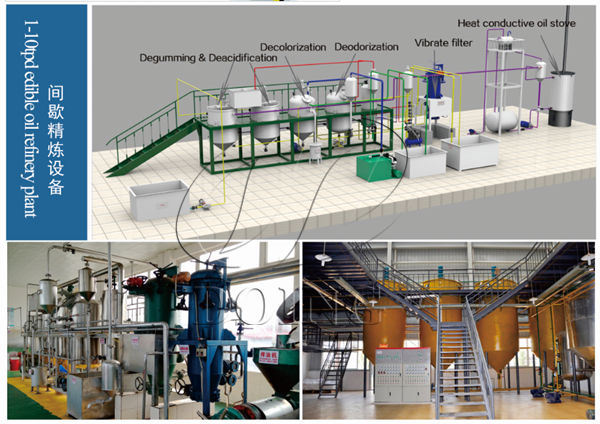
Batch edible oil refinery plant
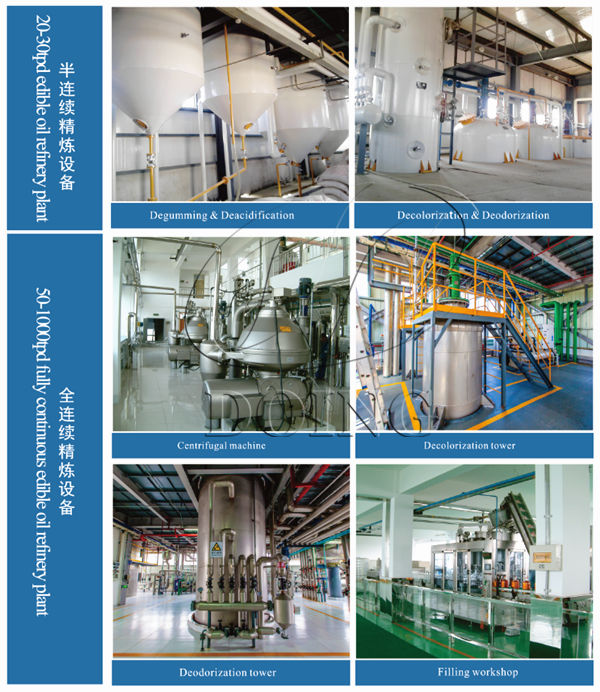
Semi-continuous oil refinery plant and continuous oil refinery plant
Specification of batch oil refinery plant, semi-continuous oil refinery plant, continuous oil refinery plant:
Crude oil--Degumming--Neutralize--Decoloring--Deodorizing--Cooling--Final oil
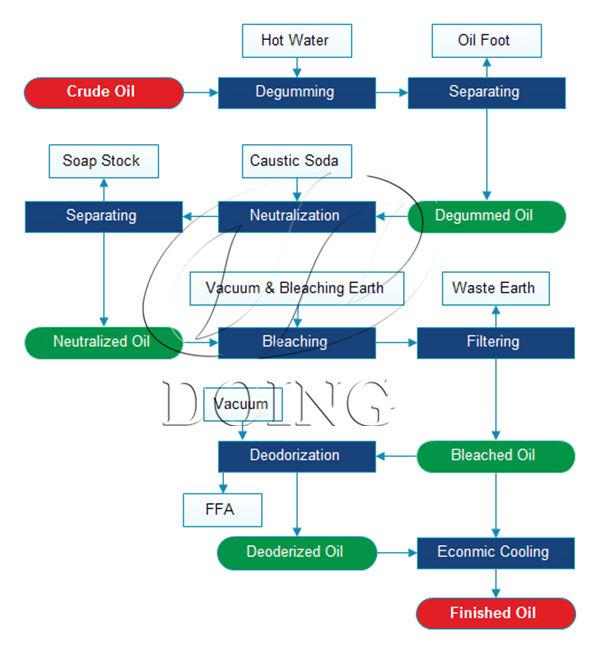
Edible oil refinery process flow diagram
Degumming section of edible oil refining machine:
This is the first step in refining and is also known as the Pretreatment Process. In the degumming process of edible oil refining machine, the gums are precipitated and separated by the centrifugal separation technique. If the gum content in the oil is low, only gum-conditioning is required to be done and there is no need to go for separate degumming process. The degumming can be carried out in the same neutralization vessel.
Neutralizing section of edible oil refining machine:
Crude cooking oil contains much free fatty acid, which is harmful for health. Free fatty acid can have reaction with caustic soda. During the reaction, it can be saponified and becomes soap stock, then small soap stock pellets will sink and become sediment and be pumped out. After neutralizing, most of the free fatty acid will be removed out.
Decoloring section of edible oil refining machine:
The main function of decoloring process is to remove oil pigment, residual soap grain and metal ions. Under negative pressure, the mechanical mixing method combined with steam mixing will improve the decoloring effect. The degummed oil firstly enters into the heater to be heated to the appropriate temperature (110°C), and then goes to the bleaching earth mixing tank. The bleaching earth is delivered from the low bleaching box to the temporary tank by wind. The bleaching earth is added by automatic metering and is interlockingly controlled with the oil.
The oil mixed with the bleaching earth overflows into the continuous decolorizer, which is stirred by non-powered steam. The decolored oil enters into the two alternate leaf filters to be filtered. Then the filtered oil enters the decolored oil storage tank through the security filter. The decolored oil storage tank is designed as the vacuum tank with the nozzle inside, so as to prevent the decolored oil contacting with the air and influencing its peroxide value and color reversion.
Deodorizing section of cooking oil refinery equipment:
The qualified decolored oil enters into the spiral plate heat exchanger to recover most of the heat, and next goes to high pressure steam heat exchanger to be heated to the process temperature (240-260°C) and then enters the deodorization tower. The upper layer of combined deodorization tower is the packing structure which is mainly used to remove the odor producing components such as free fatty acid (FFA); the bottom layer is the plate tower which is mainly for achieving the hot decoloring effect and reducing the peroxide value of the oil to zero. Oil from the deodorization tower enters into the heat exchanger to recover most of the heat and makes further heat exchange with crude oil, and then is cooled to 80-85°C through the cooler. Add the required antioxidant and flavor agent, and then cool the oil below 50°C and store it. Such volatiles as FFA from the deodorizing system are separated by the packing catcher, and the separated liquid is FFA at low temperature (60-75°C). When the liquid level in the temporary tank is too high, the oil will be sent to the FFA storage tank.
Our services
Our company always put the interests of customers, product quality and service as first, and always adhere to the"Customer’s success is our biggest wishes" as our purpose. We will be commitment to provide high quality products with perfect service. Now the specific commitments are as follows:
1.Ensure provide complete sets of equipment and accessories timely.
2.Ensure that one-time installation debugging acceptance.
3.To provide high quality material with preferential price.
4.Priority to provide customer our new craftworks and products.
5.Free training technological operator to ensure the trained staff can operation independently.
6.In the installation process,we will appoint an installation supervision staff on the spot.
7.we will offer an experienced project manager, organize a good installation team for the work.

Large scale edible oil refinery plant
We recommend the most suitable and cost effective edible oil refining production lines to start a local edible oil refining manufacture. Before starting an edible oil refining factory, it is very important to decide scale.
Crude oil obtained from expellers or solvent extraction, contains impurities. To make the oil edible, the impurities must be taken out; such a process is called “oil refining(oil refinery plant)”. Oil Refining (Oil Refinery Plant) means conversion from crude oil to direct human consumption, crude oil refinery, edible oil refinery, oil refinery projects and industrial purpose.
In general, oil refinery plant divides to 3 types: batch oil refinery plant, semi-continuous oil refinery plant, continuous oil refinery plant. These 3 oil refinery plants are used for different capacity. But the processes in each oil refinery plant are almost the same.

Batch edible oil refinery plant

Semi-continuous oil refinery plant and continuous oil refinery plant
Specification of batch oil refinery plant, semi-continuous oil refinery plant, continuous oil refinery plant:
| 1.Batch oil refinery plant | |
| Capacity (Ton/Day) | 1-10TPD |
| Application: | Process almost all kinds of crude oil for edible purpose: vegetable oil, palm oil, castor oil, sunflower oil, rice bran oil, soybean oil, canola oil, cottonseed oil, mustard oil, groundnut oil, etc. |
|
Main equipment: |
Refining pot, Decoloring pot, Deodorization tank, Steam generator, Vibrate filter, Electricity distribution control, Air compressor |
| 2. semi-continuous oil refinery plant | |
| Capacity (Ton/Day) | 10-30tpd |
| Application: | Process almost all kinds of crude oil for edible purpose: vegetable oil, palm oil, castor oil, sunflower oil, rice bran oil, soybean oil, canola oil, cottonseed oil, mustard oil, groundnut oil, etc. |
| Main equipment: | Refining reactor, Decolorization reactor, Vibrating filter, Deodorizing tower, Deodorized oil pump, Centrifugal water pump, Heat conductive oil furnace |
| 3. Continuous oil refinery plant | |
| Capacity (Ton/Day) | 30-1000tpd |
| Application: | Process almost all kinds of crude oil for edible purpose: vegetable oil, palm oil, castor oil, sunflower oil, rice bran oil, soybean oil, canola oil, cottonseed oil, mustard oil, groundnut oil, etc. |
| Main equipment: | Washing centrifuge,Vacuum dryer, Decolorization tower, Decolorization oil pump, Plate filter, Deodorization tower, Cooling tower, Thermal oil furnace |
Edible Oil Refining Manufacturing Process
Crude oil--Degumming--Neutralize--Decoloring--Deodorizing--Cooling--Final oil

Edible oil refinery process flow diagram
Degumming section of edible oil refining machine:
This is the first step in refining and is also known as the Pretreatment Process. In the degumming process of edible oil refining machine, the gums are precipitated and separated by the centrifugal separation technique. If the gum content in the oil is low, only gum-conditioning is required to be done and there is no need to go for separate degumming process. The degumming can be carried out in the same neutralization vessel.
Neutralizing section of edible oil refining machine:
Crude cooking oil contains much free fatty acid, which is harmful for health. Free fatty acid can have reaction with caustic soda. During the reaction, it can be saponified and becomes soap stock, then small soap stock pellets will sink and become sediment and be pumped out. After neutralizing, most of the free fatty acid will be removed out.
Decoloring section of edible oil refining machine:
The main function of decoloring process is to remove oil pigment, residual soap grain and metal ions. Under negative pressure, the mechanical mixing method combined with steam mixing will improve the decoloring effect. The degummed oil firstly enters into the heater to be heated to the appropriate temperature (110°C), and then goes to the bleaching earth mixing tank. The bleaching earth is delivered from the low bleaching box to the temporary tank by wind. The bleaching earth is added by automatic metering and is interlockingly controlled with the oil.
The oil mixed with the bleaching earth overflows into the continuous decolorizer, which is stirred by non-powered steam. The decolored oil enters into the two alternate leaf filters to be filtered. Then the filtered oil enters the decolored oil storage tank through the security filter. The decolored oil storage tank is designed as the vacuum tank with the nozzle inside, so as to prevent the decolored oil contacting with the air and influencing its peroxide value and color reversion.
Deodorizing section of cooking oil refinery equipment:
The qualified decolored oil enters into the spiral plate heat exchanger to recover most of the heat, and next goes to high pressure steam heat exchanger to be heated to the process temperature (240-260°C) and then enters the deodorization tower. The upper layer of combined deodorization tower is the packing structure which is mainly used to remove the odor producing components such as free fatty acid (FFA); the bottom layer is the plate tower which is mainly for achieving the hot decoloring effect and reducing the peroxide value of the oil to zero. Oil from the deodorization tower enters into the heat exchanger to recover most of the heat and makes further heat exchange with crude oil, and then is cooled to 80-85°C through the cooler. Add the required antioxidant and flavor agent, and then cool the oil below 50°C and store it. Such volatiles as FFA from the deodorizing system are separated by the packing catcher, and the separated liquid is FFA at low temperature (60-75°C). When the liquid level in the temporary tank is too high, the oil will be sent to the FFA storage tank.
Our services
Our company always put the interests of customers, product quality and service as first, and always adhere to the"Customer’s success is our biggest wishes" as our purpose. We will be commitment to provide high quality products with perfect service. Now the specific commitments are as follows:
1.Ensure provide complete sets of equipment and accessories timely.
2.Ensure that one-time installation debugging acceptance.
3.To provide high quality material with preferential price.
4.Priority to provide customer our new craftworks and products.
5.Free training technological operator to ensure the trained staff can operation independently.
6.In the installation process,we will appoint an installation supervision staff on the spot.
7.we will offer an experienced project manager, organize a good installation team for the work.
